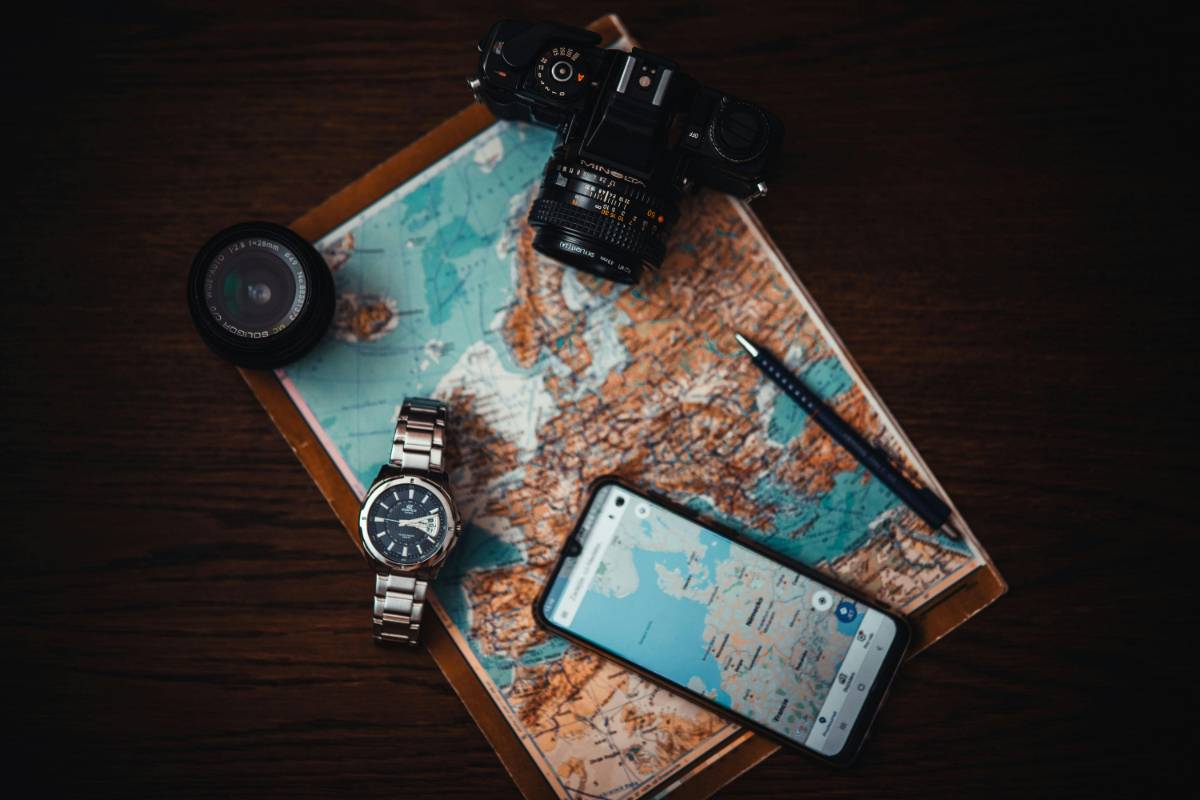
One of the first things you'll encounter when arriving in a new country is the local greeting. Handshakes, hugs, bows, or even cheek kisses may be the norm, but the way greetings are performed varies widely across cultures.
By Robert Anthony Brown · 09 Aug 2025
When traveling abroad, understanding and respecting local cultural norms is crucial for building positive relationships and avoiding misunderstandings. Every country has its own set of etiquette rules, from greeting customs to dining manners. Familiarizing yourself with these practices can enhance your travel experience and show respect for the culture you’re visiting.
 Step 1: Research Local Greetings
Step 1: Research Local GreetingsOne of the first things you'll encounter when arriving in a new country is the local greeting. Handshakes, hugs, bows, or even cheek kisses may be the norm, but the way greetings are performed varies widely across cultures.
In some countries, such as Japan, bowing is a traditional form of greeting, while in many Western cultures, a firm handshake is the standard. In the Middle East, greetings may include a kiss on both cheeks or a warm hug between close friends. Understanding these customs can help you avoid any awkwardness when meeting new people.
Step 2: Dress Appropriately for the CultureDress codes vary significantly from one country to another, and what's considered appropriate attire in your home country may not be suitable in another. Many cultures have more conservative dress codes, particularly in religious or rural areas.
For example, in some Middle Eastern and Asian countries, it’s important to dress modestly, especially when visiting religious sites. In contrast, beach destinations might encourage more casual or relaxed clothing. Always research the dress code for the country you're visiting and pack accordingly to ensure you're respectful of local customs.
Dining etiquette is one of the most important aspects of cultural etiquette. While a meal in one country may involve formal seating arrangements and specific utensils, in another, it might be a more relaxed, communal experience.
In some cultures, like in parts of Asia, it’s common to eat with chopsticks, and there are specific rules on how to use them, such as not sticking them upright in a bowl of rice. In the Middle East, sharing food from a communal plate is common, and in countries like Italy, it’s considered rude to order pasta with cream-based sauces after a certain time of day.
Religion plays a central role in many cultures, and understanding local religious practices is important for demonstrating respect. In some countries, it’s crucial to dress modestly when visiting places of worship or to remove your shoes before entering certain areas, like temples or mosques.
In predominantly Muslim countries, it’s important to be mindful of prayer times and fasting during Ramadan, when eating or drinking in public during daylight hours may be frowned upon. Always take the time to understand religious observances and be respectful during your travels.
 Step 5: Tipping Practices
Step 5: Tipping PracticesTipping customs vary from one country to another. In the United States, tipping is common and expected, but in many European countries, a service charge is often already included in the bill, making tipping optional. In some Asian countries, like Japan, tipping is not a common practice and may even be seen as disrespectful.
Before traveling, research the tipping customs in the country you’re visiting. This will help you avoid offending anyone or appearing disrespectful due to cultural differences. Understanding whether or not to tip, and how much, can enhance your experience and show appreciation for the services you receive.
Step 6: Be Mindful of Personal Space and Physical ContactDifferent cultures have different views on personal space and physical contact. In many Western countries, people value personal space and may not be comfortable with close physical contact from strangers. In contrast, cultures in the Mediterranean or Latin America may have a more relaxed view of personal space, and close physical proximity during conversations is more common.
It’s important to observe how locals interact with one another and adapt accordingly. While it’s always important to respect boundaries, understanding cultural norms can help you engage more comfortably in social situations.
Step 7: Learn Key Phrases in the Local LanguageAlthough English is widely spoken in many countries, learning a few key phrases in the local language can go a long way in making a positive impression. Simple phrases like "hello," "please," "thank you," and "excuse me" can help break the ice and show that you appreciate the local culture.
Learning a few words in the local language demonstrates respect and shows that you’ve made an effort to connect with the people and culture of the country you’re visiting. Locals often appreciate when travelers make the effort, even if it’s just a few basic phrases.
Step 8: Be Aware of Cultural Taboo SubjectsEvery culture has its taboos—subjects or actions that are considered offensive or inappropriate. These can vary widely, so it’s important to do your research before traveling. For example, discussing politics or religion may be a sensitive topic in certain cultures, and making jokes about the monarchy or national symbols can be considered highly disrespectful in others.
When traveling, be mindful of these taboos and avoid bringing up potentially offensive subjects unless you are familiar with the cultural context. This helps avoid misunderstandings and ensures that you maintain a respectful attitude throughout your travels.
Step 9: Observe Local Customs and TraditionsIn every country, there are customs and traditions that play an important role in the daily lives of locals. Whether it’s a specific holiday, ritual, or social expectation, take time to learn about these practices and participate when appropriate. Showing genuine interest in local traditions can enhance your experience and demonstrate respect for the culture.
Traveling abroad provides an opportunity to immerse yourself in a culture that may be very different from your own. By understanding and respecting local cultural norms, you not only enrich your travel experience but also foster goodwill and create meaningful connections with people you meet along the way.
Subscribe to our newsletter to get our newest articles instantly!

Senior Contributor
Robert Anthony Brown is passionate about impactful storytelling. With a unique voice and deep insights, they turn everyday stories into compelling reads that resonate and inform.
Read Full Bio
Traveling has become more convenient than ever, thanks to the power of technology. Whether it’s planning your itinerary, managing expenses, or staying informed about local weather, a wide range of travel apps can help streamline your journey. Here’s a list of must-have travel apps to make your trip smoother and more enjoyable.1163a.jpg***Google Maps: Navigation Made EasyGoogle Maps remains one of the most popular travel apps for navigation and exploration. With real-time traffic updates, offline maps, and street views, it helps you find the best routes, discover nearby attractions, and even check out reviews of restaurants and hotels. Its offline map feature is particularly useful in areas with poor internet connectivity.Another advantage of Google Maps is its public transit guidance, which provides detailed information on bus, train, and subway routes in various cities worldwide. By downloading maps of your destination beforehand, you can ensure you’re prepared for any travel situation.***Hopper: For Finding the Best Flight DealsHopper is a fantastic app for travelers seeking to save on flights. By analyzing historical price data, Hopper predicts the best time to book flights, notifying users when ticket prices drop. This feature is perfect for travelers on a budget, as it ensures you’re getting the best possible deal for your journey.In addition to flights, Hopper also provides insights on hotel prices and offers helpful travel tips based on destination trends. This app makes planning affordable travel easy, helping you secure the lowest prices on accommodations and flights.***PackPoint: Packing Made SimplePackPoint is an intuitive packing app that generates custom packing lists based on your travel details, such as destination, travel dates, and activities. It also takes into account the weather forecast at your destination, ensuring you pack appropriately for the conditions.With PackPoint, you can create personalized packing lists that you can share with fellow travelers. This app is especially useful for those who tend to overpack or forget essentials, as it helps streamline the packing process and keeps you organized.***XE Currency: Currency Conversion on the GoXE Currency is an essential app for international travelers needing quick and accurate currency conversions. The app provides real-time exchange rates and allows users to save rates for offline use. This feature is valuable in countries where internet access may be limited, ensuring you always have up-to-date information.In addition to conversion, XE Currency offers a currency rate alert feature, enabling users to set specific rates they’re interested in. This way, you’ll know when it’s a good time to exchange money for your trip.1163b.jpg***TripIt: All Your Travel Plans in One PlaceTripIt is a fantastic organizational tool that consolidates all your travel details into one itinerary. By forwarding your flight, hotel, and car rental confirmations to TripIt, the app creates a master itinerary you can access at any time. With offline access, TripIt ensures that even in areas with no internet, your travel plans are at your fingertips.For travelers with multiple bookings and destinations, TripIt’s calendar sync feature can also help keep track of each leg of your journey. This app is invaluable for staying organized and stress-free throughout your trip.***Google Translate: Language Barrier BreakerGoogle Translate is an indispensable tool for overcoming language barriers when traveling internationally. With support for dozens of languages, Google Translate provides text, voice, and photo translation. The app’s offline mode allows you to download language packs, so you’re never left struggling to communicate.One of Google Translate’s best features is its camera mode, which enables instant translation by pointing your camera at text. This is incredibly useful for reading signs, menus, and other written materials in foreign languages.***LoungeBuddy: Relaxation at the AirportLoungeBuddy is a lifesaver for travelers facing long layovers or delays. The app provides information on airport lounges worldwide, allowing users to book passes or check access options. LoungeBuddy’s search feature helps you locate lounges based on your departure or arrival airport, and it even includes reviews, photos, and amenities available in each lounge.With LoungeBuddy, you can relax in style, even if you don’t have a premium ticket or airline membership. It’s a must-have for travelers who want a comfortable experience at the airport without the usual crowds.***WhatsApp: Stay Connected with EaseWhatsApp is more than just a messaging app; it’s a vital communication tool for travelers. With end-to-end encryption, free international messaging, and support for voice and video calls, WhatsApp keeps you connected with friends and family wherever you are.WhatsApp’s group chat feature also allows you to communicate easily with fellow travelers. Its location-sharing function is particularly useful for meeting up in unfamiliar areas, and it works even in areas with limited internet service.***Conclusion: Travel Smart with the Right AppsTravel apps can transform your journey, making it more enjoyable, efficient, and stress-free. From planning and packing to navigating foreign cities and finding the best deals, these top travel apps cater to every need of a modern traveler. Download these essential apps before your next trip to enhance your travel experience and make the most of your adventure.
By Christopher David Wilson · 31 Jul 2025

Travel photography allows you to capture the essence of a destination, preserve memories, and share unique perspectives. Whether you’re an amateur or an experienced photographer, learning how to capture stunning travel photos can make your journey even more memorable. This guide provides tips and tricks to help you take breathtaking travel photos.1173a.jpg***Step 1: Choose the Right GearWhile smartphones have advanced cameras, investing in a good quality DSLR or mirrorless camera can elevate your travel photography. A versatile lens, such as a 24-70mm zoom lens, will allow you to capture wide landscapes and close-up shots with ease.In addition to the camera, make sure to carry extra memory cards, batteries, and a tripod for stability. If you’re traveling to remote locations, a lightweight camera bag that’s easy to carry is essential.***Step 2: Understand Lighting and Golden HoursThe best travel photos are often captured during the golden hours—shortly after sunrise and just before sunset. The soft, warm light creates a magical atmosphere and enhances the colors in your shots.Avoid shooting in harsh midday sunlight, which can create unflattering shadows and overexposed highlights. If you must shoot at midday, look for shaded areas or use the backlighting technique to create interesting silhouettes.***Step 3: Use the Rule of ThirdsOne of the simplest yet most effective composition techniques is the rule of thirds. Imagine dividing your image into a 3x3 grid, and position the key elements of your photo along the lines or at their intersections.For example, when photographing a landscape, place the horizon on the top or bottom third of the image rather than in the center. This adds balance and creates a more dynamic composition.***Step 4: Capture Local Life and CultureWhile landscapes are beautiful, some of the most stunning travel photos come from capturing local life and culture. Street markets, festivals, and everyday activities can tell compelling stories about a destination.Take the time to observe and interact with locals. Don’t hesitate to ask if you can photograph them, but always be respectful and considerate. Capturing candid moments adds authenticity to your travel photos.***Step 5: Experiment with Different PerspectivesA common mistake in travel photography is to shoot everything from eye level. While that’s often the most straightforward perspective, experimenting with different angles can add depth and interest to your photos.Try shooting from a low angle to make a subject appear grand and powerful, or capture a scene from a bird’s-eye view for a unique perspective. Climbing to higher ground or shooting through a frame can also create more visually striking images.***Step 6: Focus on DetailsNot every great photo needs to capture an entire scene. Focus on the small details that often get overlooked, such as textures, patterns, or the way light interacts with an object. These close-up shots can be just as stunning as wide vistas and help to tell a fuller story of your travels.When photographing architecture, for example, zoom in on intricate carvings or the play of light and shadow on a building’s surface. Small, intimate shots bring a unique perspective to your travel photo collection.1173b.jpg***Step 7: Use Natural FramingFraming is a powerful tool in photography that can help draw attention to the subject of your image. Look for natural frames in the environment, such as doorways, windows, archways, or tree branches.Positioning your subject within these frames creates a sense of depth and makes your image feel more immersive. Natural framing also adds an artistic touch to your photos and emphasizes the main subject.***Step 8: Play with ReflectionsReflections add an extra layer of intrigue to photos. Whether it’s the reflection of a building on a glass surface, a lake, or a puddle, the mirrored effect creates a visually interesting symmetry.When photographing reflections, make sure to align your shot properly so that the reflection is clear and not distorted. Additionally, play with the symmetry between the reflected and original images for added impact.***Step 9: Tell a Story with Your PhotosThe most captivating travel photos are the ones that tell a story. Instead of just capturing a beautiful scene, try to convey an emotion or narrative with your images.Consider how the lighting, composition, and subject matter can evoke a sense of wonder, adventure, or peacefulness. Think about how each shot fits into the bigger picture of your travels, and capture moments that highlight the journey rather than just the destination.***Step 10: Edit Your Photos ThoughtfullyEditing is an essential part of the photography process, but it’s important to do so in moderation. Enhance the natural beauty of your photos by adjusting exposure, contrast, and colors, but avoid over-editing to the point where the image looks unrealistic.Use editing software such as Lightroom or Snapseed to refine your shots. Simple edits like increasing sharpness, adjusting white balance, or adding a slight vignette can make your photos pop without altering their authenticity.***Step 11: Practice Patience and Be PreparedSome of the best travel photos require a little patience. Waiting for the right moment—whether it’s a passing cloud, a changing light, or the perfect person walking into the frame—can make all the difference in capturing a stunning shot.Make sure you’re always ready to shoot, keeping your camera accessible and prepared for action. The best photos often happen unexpectedly, so being patient and observant can help you capture that magical moment.Travel photography is about more than just snapping pictures; it’s about capturing the essence of a place, its people, and its culture. By following these tips and practicing your skills, you’ll be able to create a stunning portfolio of travel memories that tell the story of your adventures in a way that’s uniquely yours.
By Christopher David Wilson · 10 Aug 2025

Roulette has charmed gamblers for centuries, but the version you play often depends on where you are. In Europe, the single-zero wheel dominates, while in the United States, American Roulette with its double zero (00) reigns supreme. But why is American Roulette more popular in the US than Europe? The reasons lie in history, economics, culture, and the unique gaming spirit that defines American casinos.***A Historical AdaptationWhen French immigrants brought roulette to America in the 19th century, gambling houses adapted the game to increase profitability. By adding the double zero (00) to the wheel, they created the American version we know today. Unlike Europe, where the single zero version remained standard in casinos like Monte Carlo, American gambling halls embraced this adaptation. It became a permanent fixture in casinos across New Orleans and, later, Las Vegas, ensuring it became the norm for generations of American players.***Casino Profitability and the House EdgeThe double zero is central to American Roulette’s success in the United States. While it increases the house edge from about 2.7% (European) to 5.26% (American), casinos saw this as a way to boost profits without making the game unattractive. American players, often more focused on the thrill than on precise odds, embraced the challenge. In Europe, however, where tradition and strategy held more weight, players favored the single-zero version, which offered better chances for the gambler.***Cultural Influence of Las VegasLas Vegas has played a huge role in cementing American Roulette’s dominance in the United States. As the city rose to fame in the mid-20th century, roulette wheels with the double zero became iconic symbols of casino life. Tourists from across the country—and eventually the world—associated roulette in Vegas with the double zero design. This cultural reinforcement made American Roulette the “authentic” casino experience for U.S. gamblers, even if it carried slightly worse odds than the European version.***The Social Experience in the USAnother reason American Roulette flourished in the U.S. is its communal and social nature. Casinos in the States marketed the game as a lively, shared experience where groups could gather, cheer, and participate together. Unlike games such as blackjack or poker, roulette requires little strategy or expertise, making it appealing to casual gamblers. The double zero added a sense of unpredictability, further heightening the entertainment factor that aligned perfectly with the U.S. approach to casino gaming: fun first, odds second.***Pop Culture and Media ReinforcementFrom Hollywood films to television shows, American Roulette has consistently been portrayed as the quintessential casino game in U.S. culture. The double zero wheel often appeared in scenes set in glamorous Las Vegas casinos, embedding the image in the public imagination. European Roulette, while equally prestigious, never reached the same level of cultural prominence in American media, further reinforcing the dominance of the U.S. version.***Why It Never Took Over EuropeIn Europe, tradition and long-standing casino reputations prevented American Roulette from becoming mainstream. Legendary establishments such as the Monte Carlo Casino and others across France, Italy, and the UK held fast to the single-zero wheel. European players were also more likely to favor games that gave them a statistical advantage, rejecting the higher house edge of American Roulette. As a result, while tourists might encounter American Roulette in select European casinos, it never replaced the more player-friendly European version.***Modern-Day PopularityToday, American Roulette remains a staple in U.S. casinos, particularly in Las Vegas and Atlantic City. Online platforms catering to U.S. audiences also prioritize American Roulette, while European platforms continue to showcase the single-zero version. Interestingly, some international casinos now offer both versions to cater to diverse audiences, but in the U.S., the double zero continues to dominate.***ConclusionAmerican Roulette is more popular in the U.S. than Europe because it reflects the American gaming culture—fast, thrilling, and designed for maximum entertainment. Its historical adaptation with the double zero, strong ties to Las Vegas, and constant presence in pop culture solidified its place in American casinos. While Europeans remain loyal to their single-zero tradition, American players celebrate the unpredictability and excitement that the double zero brings to the table, ensuring its ongoing popularity in the United States.
By Stefen · 15 Aug 2025

Planning a multi-country vacation is an exciting adventure that allows you to explore diverse cultures, landscapes, and attractions. However, with so many details to organize, it can also be a bit overwhelming. From choosing the right destinations to managing logistics, here are some tips to help you plan a seamless and unforgettable multi-country trip.1174a.jpg***Step 1: Choose Your Destinations WiselyThe first step in planning a multi-country vacation is selecting the destinations you want to visit. Consider regions that are geographically close to each other to minimize travel time and costs between countries. For example, traveling through Western Europe, Southeast Asia, or Central America can be more efficient than hopping between distant continents.It’s also essential to think about the type of experience you want. Are you looking to explore cities, relax on beaches, or immerse yourself in nature? Make sure your destinations offer a variety of activities that suit your interests and needs.***Step 2: Research Travel Restrictions and VisasBefore you start booking flights and accommodations, check the visa requirements and travel restrictions for each country you plan to visit. Many countries have specific visa policies, and some may require you to obtain a visa in advance, while others may offer visa-on-arrival services.Also, stay updated on any COVID-19 regulations, including quarantine requirements or vaccine documentation. Knowing this information in advance will help you avoid unexpected complications during your trip.***Step 3: Plan Your Route and TransportationOnce you’ve narrowed down your destinations and taken care of visa requirements, it’s time to plan your route. Think about how you’ll get from one country to another and the most efficient transportation options available.Flying between major cities is often the quickest and most convenient option. Look for budget airlines or travel passes that allow you to visit multiple cities at a discounted rate. Alternatively, train and bus services may be more scenic and affordable options, especially in regions like Europe and Southeast Asia.***Step 4: Create a Realistic ItineraryWith multiple countries to visit, it’s crucial to create a balanced and realistic itinerary. Don’t over-pack your schedule by trying to see everything at once. Instead, prioritize your must-see attractions and leave room for spontaneity.Be sure to factor in travel time between destinations. Some countries are larger than others, and you may spend several hours on a train or plane just getting from one place to another. Leave at least one full day in each city to explore before moving on to the next destination.***Step 5: Budget for the TripA multi-country vacation can be expensive, so it’s essential to budget for the entire trip. Start by estimating how much you’ll need for flights, accommodation, meals, and activities in each country. Don’t forget to factor in the cost of transportation between countries and any entry fees for museums, parks, or attractions.Consider using budgeting apps or spreadsheets to track your spending throughout the trip. You can also save money by staying in hostels, booking tours in advance, or choosing destinations with a lower cost of living.***Step 6: Pack Light and SmartPacking for a multi-country trip can be tricky, as you’ll need to prepare for a variety of climates and activities. The key is to pack light and versatile items that can be mixed and matched for different occasions.Pack clothing that can be layered, as temperatures can vary from one country to another. Comfortable shoes are a must, especially if you plan to do a lot of walking. Don’t forget travel-sized toiletries, a portable charger, and a daypack for sightseeing.1174b.jpg***Step 7: Stay Connected and Plan for CommunicationStaying connected while traveling through multiple countries can be a challenge. Look into purchasing a global SIM card or an international roaming plan that allows you to use your phone in several countries without incurring hefty fees.Alternatively, consider relying on Wi-Fi for communication. Many cafes, hotels, and public spaces offer free Wi-Fi, so you can use messaging apps or make calls through Wi-Fi networks. It’s also helpful to download offline maps and translation apps to navigate unfamiliar places.***Step 8: Learn the Basics of Local LanguagesWhile English is widely spoken in many countries, it’s always a good idea to learn a few key phrases in the local language. Simple greetings, thank you, and please can go a long way in making connections and showing respect for the local culture.Before you go, consider downloading language apps like Duolingo or Google Translate to help you with translations during your trip. Knowing a little of the local language will also enrich your experience and make your trip more enjoyable.***Step 9: Be Flexible and Embrace the UnexpectedOne of the most important tips for a multi-country vacation is to remain flexible. While it’s great to have an itinerary, things can change unexpectedly, whether it’s due to weather, transportation delays, or changes in local regulations.Embrace the unexpected and be open to spontaneous adventures. Some of the best travel memories come from unplanned moments, like discovering a hidden gem or meeting new people along the way.***Step 10: Stay Safe and Keep Important Documents SecureWhen traveling through multiple countries, it’s essential to prioritize your safety and keep important documents secure. Keep copies of your passport, visa, and other crucial documents in a separate location from the originals.Consider investing in a travel money belt or neck pouch to keep your passport and credit cards safe from pickpockets. Additionally, research the safety tips and guidelines for each country you’re visiting and stay informed about any potential risks.***Step 11: Enjoy the JourneyFinally, remember that travel is about enjoying the experience and embracing the journey. Take time to enjoy the sights, meet locals, and immerse yourself in the cultures you encounter. Don’t rush from one destination to the next, and make sure to savor every moment of your multi-country vacation.By following these tips and planning ahead, you can ensure a smoother and more enjoyable experience as you explore multiple countries. Whether it’s your first multi-country trip or your 10th, thoughtful preparation will help you create lasting memories and make the most of your adventure.
By Abraham Benjamin · 11 Aug 2025